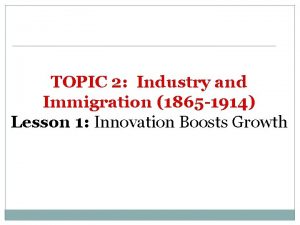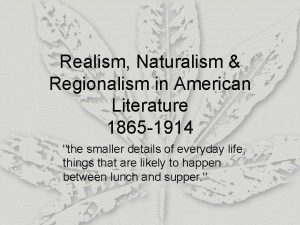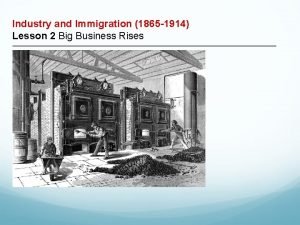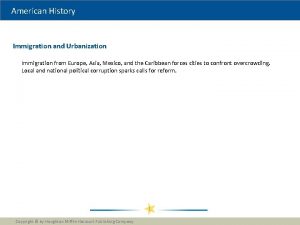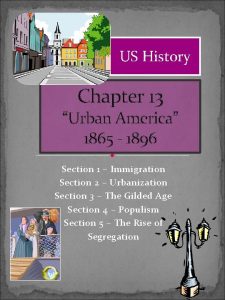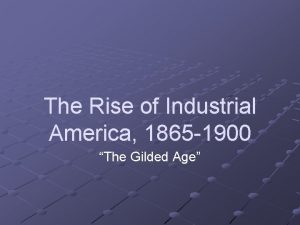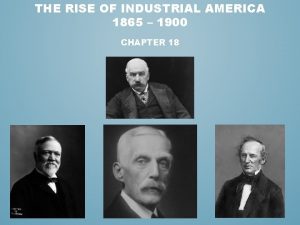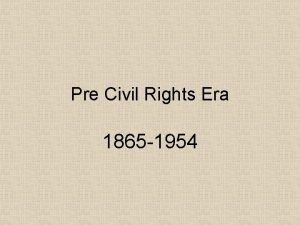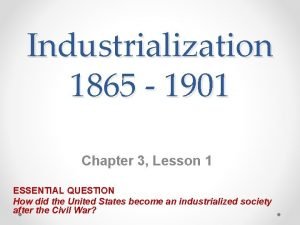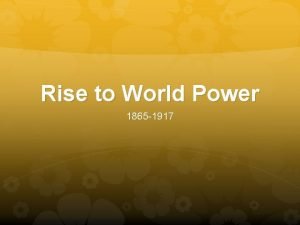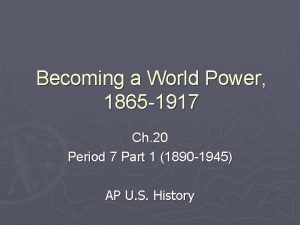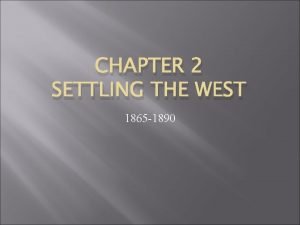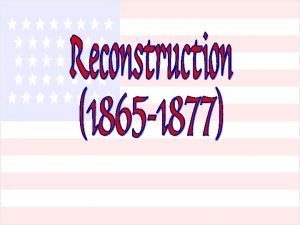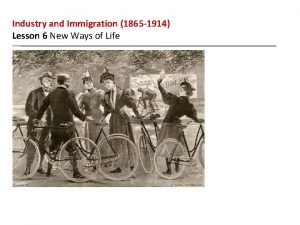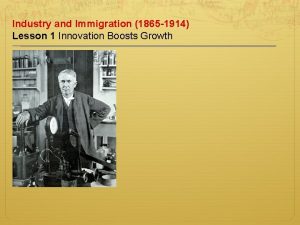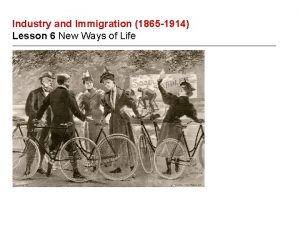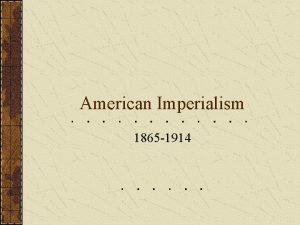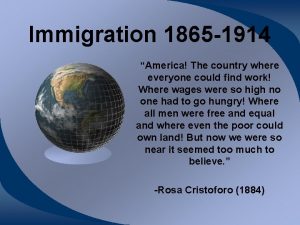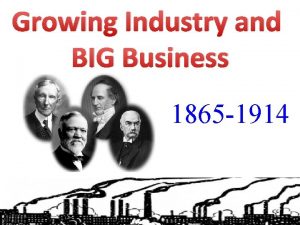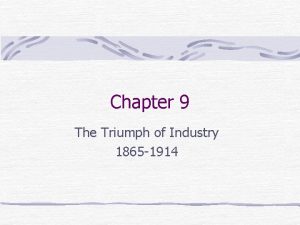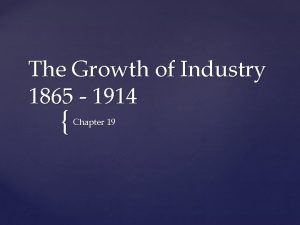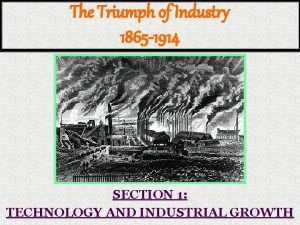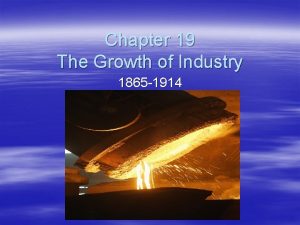TOPIC 2 Industry and Immigration 1865 1914 Lesson



















- Slides: 19

TOPIC 2: Industry and Immigration (1865 -1914) Lesson 3 The Organized Labor Movement

Learning Objectives • Assess the impact of business practices on workers in the late 1800 s. • Compare the goals and strategies of the first labor unions. • Analyze the causes and effects of strikes in the late 1800 s.

Workers Endure Difficulties • Industry was booming wealth for owners of companies and large farms • Improvements to society (more products/ lower prices, higher standard of living, public institutions) • Factory work • Immigrants, women and children (1/5 children worked instead of school) • low pay, long hours, 6 days a week • Dangerous sweatshops

Women working on a sewing machine in a shoe factory in the late nineteenth century.


Workers Endure Difficulties • Company towns • Owned by the businesses and rented to employees (required) • “company store” : workers forced to buy from • • • Sold on credit (high interest) segregated increased racial tension “Wage slavery”

The Growth of Labor Unions • Early protests focused on wages, working conditions • Workers wanted the right to collective bargaining • Labor unions influenced by Socialism • Economic and political policy that favors public vs. private control of property • Wealth spread to everyone (Karl Marx) • Owners saw this as a threat to free enterprise

The Growth of Labor Unions • Knights of Labor • 1869 labor union (skilled and unskilled) • Included African Americans • Secret society; focused on social reform too • Terence Powderly= leader • 1885 700, 000 members, but disappeared after failed strikes

The Growth of Labor Unions • American Federation of Labor (AFL) • Samuel Gompers • Craft union (only skilled workers) • Dues for membership • Focus on wages, working hours, working conditions • “bread and butter” union • No women allowed!

The Growth of Labor Unions Different labor unions continued to advocate for worker's rights. Analyze Tables How were all of these labor unions similar? What were some ways in which they differed?

Labor Unions Lead Protests • First major national strike 1877: Great Railway Strike • Workers angry over cut wages • Haymarket Riot • 1886 wanted 8 hour work day rallies across US • In Chicago: protestors rallied at Haymarket Square • Group included radicals (socialists, anarchists) • Conflict with police • Protestor threw bomb, killed policeman • End of Knights of Labor public turned against this union

Burning of Pennsylvania Railroad and Union Depot, Pittsburgh, Pennsylvania, 21– 22 July 1877 (Tom Scott) Haymarket Riot, 1886 Chicago

Labor Unions Lead Protests • Homestead Strike • 1892 Carnegie steel plant cut wages, workers went on strike • Henry Frick (manager at Homestead) brought in the Pinkerton Detective Agency to protect strikebreakers • Killed several strikers • Union called off strike when anarchist attempted to murder Frick (public opinion turned against union)

Labor Unions Lead Protests • Pullman Strike 1893 -94 • Pullman Palace Car Co. laid off workers and cut wages by 25% (railroad workers) • Workers lived in company towns (rent stayed the same) • Eugene V. Debs (American Railway Union) called for national strike (300, 000 man strike) • President called in federal troops—Sherman Antitrust Act to force workers back to work • Strike was disrupting “interstate commerce” • Debs sent to jail and created radical union, Industrial Workers of the World (IWW or Wobblies)

Labor Unions Lead Protests Industrial Workers of the World (IWW) rally in protest in Union Square in New York City, New York.

Labor Unions Lead Protests Company towns like this one provided everything workers would need, but at a significant cost. Analyze Graphs What reasons account for the workers' complaints about Pullman?

Quiz: Workers Endure Difficulties What does the term “wage slavery” refer to? A. The practice of paying low wages for extremely long hours of work B. The fact that mine workers had no place to live but in a “company town” C. The fact that workers couldn’t leave a job while owing money to the employer D. The reality of laboring in a mine while undergoing ethnic competition and distrust

Quiz: The Growth of Labor Unions The AFL differed from the Knights of Labor in that A. B. C. D. the AFL preferred their members not strike. the AFL did not charge membership dues. the AFL welcomed skilled and unskilled workers. the AFL did not advocate for broad social change.

Quiz: Labor Unions Lead Protests From the first major strike in 1877 through the Pullman strike in 1893, all major strikes A. B. C. D. were unsuccessful. made only small gains for workers. involved the use of federal troops. involved anarchists and arrests.
 Industry and immigration lesson 1 innovation boosts growth
Industry and immigration lesson 1 innovation boosts growth Topic 2 industry and immigration
Topic 2 industry and immigration Regionalism american literature
Regionalism american literature Lesson 2 big business rises
Lesson 2 big business rises Immigration and urbanization new technologies lesson 4
Immigration and urbanization new technologies lesson 4 Specific topic examples
Specific topic examples Research problem example for students
Research problem example for students Urban america 1865 to 1896
Urban america 1865 to 1896 Hollywood silver fox farm v emmett
Hollywood silver fox farm v emmett The rise of industrial america 1865-1900
The rise of industrial america 1865-1900 The rise of industrial america 1865-1900
The rise of industrial america 1865-1900 15 th ammendment
15 th ammendment Industrialization (1865 to 1901 worksheet answers key)
Industrialization (1865 to 1901 worksheet answers key) Becoming a world power 1865-1917
Becoming a world power 1865-1917 Impressionism characteristics
Impressionism characteristics Chapter 20 becoming a world power notes
Chapter 20 becoming a world power notes Settling the west 1865 to 1890
Settling the west 1865 to 1890 Gregor mendel 1865
Gregor mendel 1865 Where did the term impressionism come from
Where did the term impressionism come from 1877-1865
1877-1865
